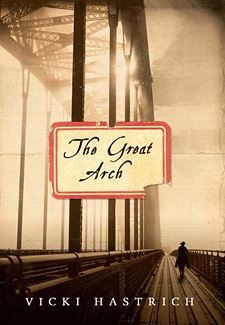 The Great Arch is a curious book. It is about a man and a bridge; it is a mix of fiction and non-fiction; and it is part-memoir and part-philosophical treatise.
The Great Arch is a curious book. It is about a man and a bridge; it is a mix of fiction and non-fiction; and it is part-memoir and part-philosophical treatise.
It is set in 1924, and the reverend Ralph Anderson Cage is the rector of Lavender Bay, the best place to be to watch the unfolding drama of the Sydney Harbour Bridge.
Reverend Cage is not content just to watch, however, he immerses himself in the bridge-building activity, taking notes and photographs in preparation for a two-volume book.
He is also Rector to a parish that is being decimated by the demolitions necessary for the expressway and pylons. He also remains Rector following the completion of the bridge, through the Great Depression, and the Second World War. Yet his awkwardness with people makes it difficult for him to effectively minister to the great emotional needs around him.
Instead, he is much more comfortable in close proximity to his beloved bridge. In some ways he is born 70 years too early. These days he would have been made Chaplain to the Bridge construction, and given encouragement and support to integrate his passion and ministry.
Instead, his obsession with the Bridge is humiliating to his family, frustrating to his congregation and frowned upon by the church establishment.
Author Vicki Hastrich has done an excellent job of maintaining interest in the long narrative by combining reflection, newspaper articles, coroner reports, excerpts from parish newsletters, as well as excerpts and quotes from Cage's book on the bridge.
It is an interesting read, enhanced by knowing it is based on true events. Reverend Cage is modelled on Reverend Frank Cash, the parish priest of Christ Church Lavender Bay. Although in the book Cage is portrayed as eccentric and foolish (although endearing) it is good to remember that Reverend Cash was a metallurgist before he was a priest, and that he was a Registrar with the Australian College of Theology.
It is true that he too had unlimited access to the Bridge construction, and also published a book: Parables of the Bridge. The original Minox camera Reverend Cash used and a selection of his photographs are on permanent display in the Pylon Museum at the Bridge.
In her research of Cash, Hastrich developed the theme of getting caught up in events that are too big or destructive, as well as his glimpse of the divine in the everyday.
However, this is not fictionalised biography, and Hastrich has clearly manufactured most of the details of Cage's life, family and relationships.
The Great Arch should be enjoyed simply as a work of fiction. Those reading the book for biography, detailed history, theological insight or inspiration for ministry would be disappointed.
Reverend Cage is a faithful servant of his Master while others fall away around him, but he allows his obsession to distract him from his study of the Word, his family, and even his religious duties.
Instead of taking the Word to the world around him; he looks for connections - often very loose - between the Gospel and what he is truly focussed on, almost as justification of that fascination. Like all obsessions, the thing attracted to blinds him to the needs and feelings of those around him.
A great opportunity becomes a series of great disappointments and regrets. This is an engaging read about things that affect us all. Perhaps it is a cautionary tale?
PS: For those who like to read along, I am currently leafing through Solo by Rana Dasgupta and The Cellist of Sarajevo by Steven Galloway.

















